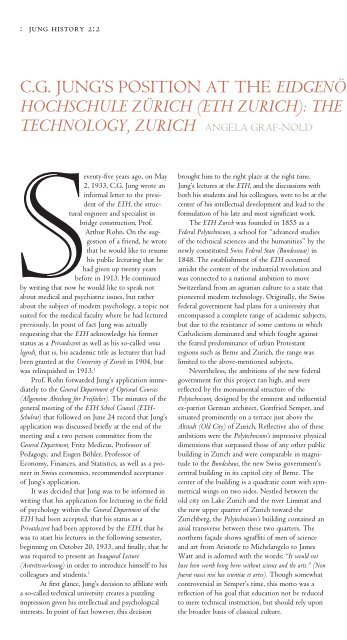a semi-annual publication of the philem n foundation - Philemon ...
a semi-annual publication of the philem n foundation - Philemon ...
a semi-annual publication of the philem n foundation - Philemon ...
You also want an ePaper? Increase the reach of your titles
YUMPU automatically turns print PDFs into web optimized ePapers that Google loves.
: jung history 2:2<br />
C.G. JUNG’S POSITION AT THE EIDGENÖ<br />
HOCHSCHULE ZÜRICH (ETH ZURICH): THE<br />
TECHNOLOGY, ZURICH ANGELA GRAF-NOLD<br />
eventy-five years ago, on May<br />
2, 1933, C.G. Jung wrote an<br />
informal letter to <strong>the</strong> president<br />
<strong>of</strong> <strong>the</strong> ETH, <strong>the</strong> structural<br />
engineer and specialist in<br />
bridge construction, Pr<strong>of</strong>.<br />
Arthur Rohn. On <strong>the</strong> suggestion<br />
<strong>of</strong> a friend, he wrote<br />
that he would like to resume<br />
his public lecturing that he<br />
had given up twenty years<br />
before in 1913. He continued<br />
by writing that now he would like to speak not<br />
about medical and psychiatric issues, but ra<strong>the</strong>r<br />
about <strong>the</strong> subject <strong>of</strong> modern psychology, a topic not<br />
suited for <strong>the</strong> medical faculty where he had lectured<br />
previously. In point <strong>of</strong> fact Jung was actually<br />
requesting that <strong>the</strong> ETH acknowledge his former<br />
status as a Privatdozent as well as his so-called venia<br />
legendi, that is, his academic title as lecturer that had<br />
been granted at <strong>the</strong> University <strong>of</strong> Zurich in 1904, but<br />
was relinquished in 1913. 1<br />
Pr<strong>of</strong>. Rohn forwarded Jung’s application immediately<br />
to <strong>the</strong> General Department <strong>of</strong> Optional Courses<br />
(Allgemeine Abteilung für Freifächer). The minutes <strong>of</strong> <strong>the</strong><br />
general meeting <strong>of</strong> <strong>the</strong> ETH School Council (ETH-<br />
Schulrat) that followed on June 24 record that Jung’s<br />
application was discussed briefly at <strong>the</strong> end <strong>of</strong> <strong>the</strong><br />
meeting and a two person committee from <strong>the</strong><br />
General Department, Fritz Medicus, Pr<strong>of</strong>essor <strong>of</strong><br />
Pedagogy, and Eugen Böhler, Pr<strong>of</strong>essor <strong>of</strong><br />
Economy, Finances, and Statistics, as well as a pioneer<br />
in Swiss economics, recommended acceptance<br />
<strong>of</strong> Jung’s application.<br />
It was decided that Jung was to be informed in<br />
writing that his application for lecturing in <strong>the</strong> field<br />
<strong>of</strong> psychology within <strong>the</strong> General Department <strong>of</strong> <strong>the</strong><br />
ETH had been accepted, that his status as a<br />
Privatdozent had been approved by <strong>the</strong> ETH, that he<br />
was to start his lectures in <strong>the</strong> following semester,<br />
beginning on October 20, 1933, and finally, that he<br />
was required to present an Inaugural Lecture<br />
(Antrittsvorlesung) in order to introduce himself to his<br />
colleagues and students. 2<br />
At first glance, Jung’s decision to affiliate with<br />
a so-called technical university creates a puzzling<br />
impression given his intellectual and psychological<br />
interests. In point <strong>of</strong> fact however, this decision<br />
brought him to <strong>the</strong> right place at <strong>the</strong> right time.<br />
Jung’s lectures at <strong>the</strong> ETH, and <strong>the</strong> discussions with<br />
both his students and his colleagues, were to be at <strong>the</strong><br />
center <strong>of</strong> his intellectual development and lead to <strong>the</strong><br />
formulation <strong>of</strong> his late and most significant work.<br />
The ETH Zurich was founded in 1855 as a<br />
Federal Polytechnicum, a school for “advanced studies<br />
<strong>of</strong> <strong>the</strong> technical sciences and <strong>the</strong> humanities” by <strong>the</strong><br />
newly constituted Swiss Federal State (Bundesstaat) in<br />
1848. The establishment <strong>of</strong> <strong>the</strong> ETH occurred<br />
amidst <strong>the</strong> context <strong>of</strong> <strong>the</strong> industrial revolution and<br />
was connected to a national ambition to move<br />
Switzerland from an agrarian culture to a state that<br />
pioneered modern technology. Originally, <strong>the</strong> Swiss<br />
federal government had plans for a university that<br />
encompassed a complete range <strong>of</strong> academic subjects,<br />
but due to <strong>the</strong> resistance <strong>of</strong> some cantons in which<br />
Catholicism dominated and which fought against<br />
<strong>the</strong> feared predominance <strong>of</strong> urban Protestant<br />
regions such as Berne and Zurich, <strong>the</strong> range was<br />
limited to <strong>the</strong> above-mentioned subjects.<br />
Never<strong>the</strong>less, <strong>the</strong> ambitions <strong>of</strong> <strong>the</strong> new federal<br />
government for this project ran high, and were<br />
reflected by <strong>the</strong> monumental structure <strong>of</strong> <strong>the</strong><br />
Polytechnicum, designed by <strong>the</strong> eminent and influential<br />
ex-patriot German architect, Gottfried Semper, and<br />
situated prominently on a terrace just above <strong>the</strong><br />
Altstadt (Old City) <strong>of</strong> Zurich. Reflective also <strong>of</strong> <strong>the</strong>se<br />
ambitions were <strong>the</strong> Polytechnicum’s impressive physical<br />
dimensions that surpassed those <strong>of</strong> any o<strong>the</strong>r public<br />
building in Zurich and were comparable in magnitude<br />
to <strong>the</strong> Bundeshaus, <strong>the</strong> new Swiss government’s<br />
central building in its capitol city <strong>of</strong> Berne. The<br />
center <strong>of</strong> <strong>the</strong> building is a quadratic court with symmetrical<br />
wings on two sides. Nestled between <strong>the</strong><br />
old city on Lake Zurich and <strong>the</strong> river Limmat and<br />
<strong>the</strong> new upper quarter <strong>of</strong> Zurich toward <strong>the</strong><br />
Zurichberg, <strong>the</strong> Polytechnicum’s building contained an<br />
axial transverse between <strong>the</strong>se two quarters. The<br />
nor<strong>the</strong>rn façade shows sgraffiti <strong>of</strong> men <strong>of</strong> science<br />
and art from Aristotle to Michelangelo to James<br />
Watt and is adorned with <strong>the</strong> words: “It would not<br />
have been worth being born without science and <strong>the</strong> arts.” (Non<br />
fuerat nasci nisi has scientiae et artes). Though somewhat<br />
controversial in Semper’s time, this motto was a<br />
reflection <strong>of</strong> his goal that education not be reduced<br />
to mere technical instruction, but should rely upon<br />
<strong>the</strong> broader basis <strong>of</strong> classical culture.


